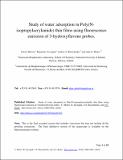| dc.contributor.author | Morris, Cheryl | |
| dc.contributor.author | Szczupak, Boguslaw | |
| dc.contributor.author | Ryder, Alan G. | |
| dc.date.accessioned | 2012-09-28T18:22:30Z | |
| dc.date.available | 2012-09-28T18:22:30Z | |
| dc.date.issued | 2010 | |
| dc.identifier.citation | Morris,C.,Szczupak,B.,Klymchenko,A.S.,Ryder,A.G. (2010) 'Study of water adsorption in PolyN-isopropylacrylamide) thin films using fluorescence emission of 3-hydroxyflavone probes'. Macromolecules, 43 (22):9488-9494. | en_US |
| dc.identifier.issn | 1520-5835 | |
| dc.identifier.uri | http://hdl.handle.net/10379/2980 | |
| dc.description | Journal article | en_US |
| dc.description.abstract | The noncontact measurement of water uptake in microscale , thermoresponsive poly(N-isopropylacrylamide) thin films is challenging. We assessed the efficacy of three different 3-hydroxyflavone (3-HF)-based fluorophores to monitor water uptake in pNIPAM thin films close to the lower critical solution temperature (LCST) at 25 and 37 °C. These 3-HF fluorophores undergo excited-state intramolecular proton transfer, yielding emission from normal (N*) and tautomeric (T*) excited-state forms. The emission intensity ratio, log(IN*/IT*), and N* band position are environmentally sensitive. Water adsorption in pNIPAM thin films follows a nonlinear, two-phase process: at low relative humidity, the adsorbed water disrupts polymer-fluorophore hydrogen bonding, yielding small changes in log(IN*/IT*) ratios and overall intensity; at higher relative humidity, these intensity parameters (but not fluorescence lifetime) change dramatically, indicating a larger change in local polarity. These probes are thus sensitive indicators of water uptake in pNIPAM. | en_US |
| dc.description.sponsorship | Science Foundation Ireland [Research Frontiers Grant number 07/RFP/MASF423] | en_US |
| dc.format | application/pdf | en_US |
| dc.language.iso | en | en_US |
| dc.publisher | ACS Publications | en_US |
| dc.relation.ispartof | Macromolecules | en |
| dc.rights | Attribution-NonCommercial-NoDerivs 3.0 Ireland | |
| dc.rights.uri | https://creativecommons.org/licenses/by-nc-nd/3.0/ie/ | |
| dc.subject | Polymer | en_US |
| dc.subject | Thermoresponsive | en_US |
| dc.subject | Fluorescence | en_US |
| dc.subject | Humidity | en_US |
| dc.subject | 3-Hydroxyflavone | en_US |
| dc.subject | ESIPT | en_US |
| dc.subject | LCST | en_US |
| dc.title | Study of water adsorption in PolyN-isopropylacrylamide) thin films using fluorescence emission of 3-hydroxyflavone probes | en_US |
| dc.type | Article | en_US |
| dc.date.updated | 2012-08-17T14:42:29Z | |
| dc.identifier.doi | 10.1021/ma102152j | |
| dc.local.publishedsource | http://dx.doi.org/10.1021/ma102152j | en_US |
| dc.description.peer-reviewed | peer-reviewed | |
| dc.contributor.funder | |~| | |
| dc.internal.rssid | 1159089 | |
| dc.local.contact | Alan Ryder, School Of Chemistry, Room 228, Arts/Science Building, Nui Galway. 2943 Email: alan.ryder@nuigalway.ie | |
| dc.local.copyrightchecked | Yes | |
| dc.local.version | ACCEPTED | |
| nui.item.downloads | 484 | |


